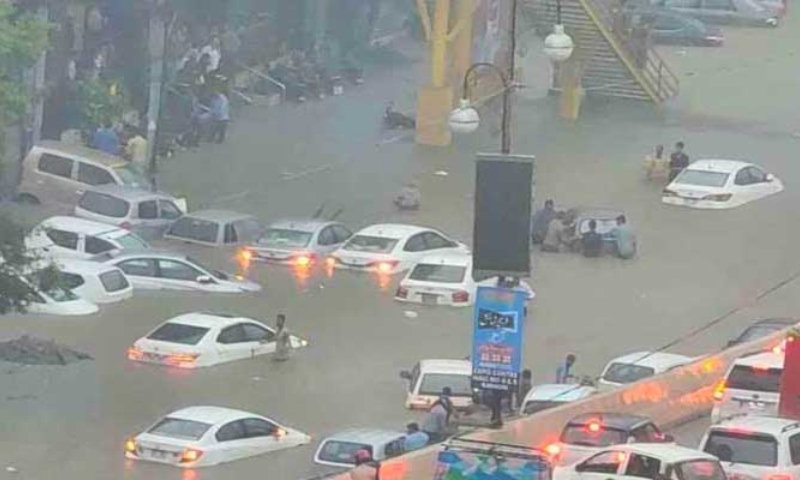- Web Desk
- 4 Hours ago
Heavy rain lashes parts of Karachi again, citizens asked to stay indoors
-
- Web Desk
- Aug 20, 2025

KARACHI: Rain has once again hit several parts of the metropolitan city while drainage of water from the previous day’s downpour has yet to be completed.
The Met Office had forecast heavy showers in Karacahi after 2 pm.
In Karachi, at least seven people have died since the rains began in the southern port city on Tuesday, Reuters quoted provincial government spokesperson Abdul Wahid Halepoto as saying. Rainfall reached levels not seen in years in some parts of the city, Pakistan’s largest, with a population of more than 20 million.
Deaths were caused by drowning, road accidents, building collapse and electrocution, Halepoto said.
On Wednesday, heavy rain was reported in Mehmoodabad, Shah Faisal Colony and adjoining areas, while rainfall also began in Saddar, MA Jinnah Road and Frere Hall. Showers were further recorded around Jinnah Hospital, Kala Pul, PECHS, Nursery, Shahrah-e-Faisal, Gulshan-e-Iqbal, Korangi and Defence.
Pakistan increasingly in the eye of the storm
Karachi Mayor Murtaza Wahab has advised citizens to remain indoors.
Rain started during Mayor Wahab’s press conference. Addressing reporters, he said Karachi had received 245 millimetres of rain during a spell that lasted four to five hours on Tuesday.
He said that Karachi’s storm drains can manage up to 40 millimetres of rainfall, but the heavy downpour had caused difficulties for citizens, followed by criticism and political crossfire.
In a post on social media platform X, Wahab urged people to avoid unnecessary movement and remain in their homes or offices during the rain. He also advised citizens not to use Shaheed-e-Millat Road, where drainage work is still under way, and to take alternate routes instead.
Despite several hours passing since the rain stopped, water could not be cleared from many roads.
Rainwater is still accumulated on Aiwan-e-Sadr Road, Ziauddin Ahmed Road, Guru Mandir, Numaish, M.A. Jinnah Road, Sindh Assembly, Drigh Road underpass, Jinnah Avenue from Malir Halt to Model Colony, Urdu Bazaar and other areas within the Red Zone.
Several areas of the city’s Red Zone, including Ziauddin Ahmed Road, Aiwan-e-Sadr Road and MR Kiyani Road, remain inundated with rainwater up to the level of sidewalks.
At Korangi’s Vita Chowrangi, drainage work could not be carried out, leaving trailers stranded since last night struggling to move.
In Korangi Industrial Area, Shahrah-e-Faisal and other major roads, many residents abandoned their vehicles, though water was later cleared from Shahrah-e-Faisal, Liaquatabad and several other streets.
On Tuesday, stagnant water on key arteries triggered massive traffic jams, leaving office-goers and commuters stranded for hours.
The rain also further damaged Karachi’s already dilapidated roads. In New Town, potholes caused vehicles to sink, while abandoned cars and motorcycles remain stuck on many roads.
Meanwhile, power supply has not been restored in several neighbourhoods since Tuesday. Areas still without electricity include Gulistan-e-Jauhar blocks 7, 18, 13 and 8; multiple blocks of Gulshan-e-Iqbal; Korangi; Mehmoodabad; Akhtar Colony; Manzoor Colony; Defence View; and Malir Alamgir Society.
Separately, army and Sindh Rangers personnel were deployed across the city to assist residents.
Security forces remained on key roads late into the night to restore traffic flow, moving stalled vehicles to the roadside and repairing some with mechanical support.
The monsoon has brought havoc across Pakistan in recent days with the death toll from flash floods that struck the mountainous northwest on Friday rising to 377.
Authorities ordered educational institutions and offices to shut.
“We are expecting more intense rains,” said Anjum Nazir, a spokesperson for the provincial meteorological department.
Tuesday’s rain was recorded between 80 mm (3.15 inches) and 178 mm (7.01 inches) in different parts of the city, he said.
Nazir said the area around the airport received 163.5 mm of rain, the highest recorded there since 1979. Some 178 mm of rain was recorded in the northeast of the city, the highest since the weather station there was set up five years ago.
The rain also disrupted power, mobile phone services and flights, officials said. Local television footage showed cars and other vehicles floating down streets, with houses submerged in water.
Karachi Electric said the sudden downpour had caused some disruption to its distribution network.
Restoration efforts faced significant challenges due to waterlogging, access and overall traffic congestion in the city, its spokesperson said.
He said KE teams were able to restore the majority of electricity feeders within eight to 12 hours.
Rescue workers, police, volunteers and government agencies were helping relief efforts, the city’s Mayor Murtaza Wahab told a press conference.
“We are using all our resources to clear roads and restore utilities,” he said.
Wahab said the rain had overwhelmed the city’s infrastructure, adding that the city’s drainage system has the capacity to handle 40 mm rain, and that anything above that would spill over into flooding.
Many schools in the city were closed for a second straight day on Wednesday, while train services were disrupted.
Authorities requested residents avoid venturing out as more rain was predicted.





